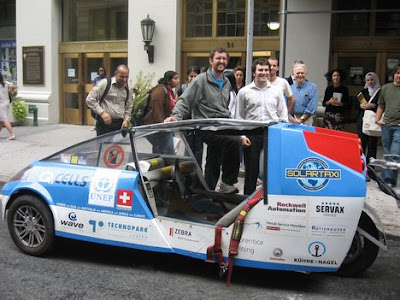Solar Taxi

Louis Palmer took his solar taxi on a quick tour through New York City the other week, making pit stops at Green Drinks, NYU, and Wall Street. Although it was a quick trip—Louis spent only eight days total in New York—it was the longest time Palmer has spent in any one location in the past year. Cruising around in the taxi at speeds of up to 55 mph, Louis has traveled 57,000 kilometers in one year.

Where has the Solar Taxi been?
Palmer started the expedition 14 months ago and ecstatically exclaims that this has been the best time of his life. Louis’s adventures have taken him to Bali to speak at the U.N., where his solar taxi was the official taxi for the U.N. ministers. A Greenpeace boat gave Louis and his taxi a ride from Bali to New Zealand, and then to Australia, Malaysia and China. The car also traveled to Malibu and got driven by celebrities like James Cameron, Jay Leno, and Tony Shalhoub.
Louis had help from 200 people to make the taxi, which has a Swiss license plate. Before he went to Saudia Arabia, Louis said his friends warned him, “You know you are visiting a very petroleum-friendly country, you might get shot.” But Saudi Arabia proved Louis’s friends wrong, giving him special permission and a police escort for his tour. He felt like a king! Only Japan said no to the vehicle, because, Louis referred cryptically, to some disagreement with Switzerland from 1946.
What inspired Louis?
Louis was prompted to build the taxi by the frustration of waiting for the world to catch up to technology. Ever sine he was a little boy, Louis says, he heard businessmen and government officials saying fuel and hydrogen cells were ten years away. “Solar works and it is here now,” says Louis, “and it is shameful that we need to beg for money for it.”
How much does it cost? Is it reliable?
The Solar cells that power the taxi’s battery cost $5,000 dollars, and Louis’s car can be produced commercially for $10,000. Louis can drive the car without the solar-paneled trailer, but the trailer is useful for educational purposes and for long distance trips. Solar cars result not just in protecting the environment, but in saving people money in the long run. Louis wants to demonstrate that the technology is reliable. Over the tour’s 14 months he has lost only two days for repairs and the car is still using its original batteries and all other original parts. To go around the world all Louis needed were two batteries. It takes six hours to charge the taxi for 200 miles of driving.
In New York City, people have appreciated the taxi for its compact size, which is ideal for city parking. People wondered if NYC had enough sun (it was raining at Green Drinks and at NYU), but as Louis astutely points out, New York gets more sun than Switzerland does. But the top question he gets is: why only 55 mph? That speed was all Louis needed to get around the world, but now that he realizes how important speed is to people, Louis says the next iteration will go up to 155 mph and will have 4 wheels. Sometime in 2009, Louis also plans to do an electric car race, getting movie stars to race solar cars, and he is even plotting an “electric car Olympics!”
